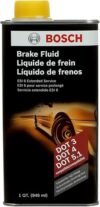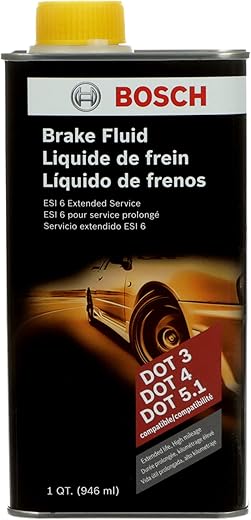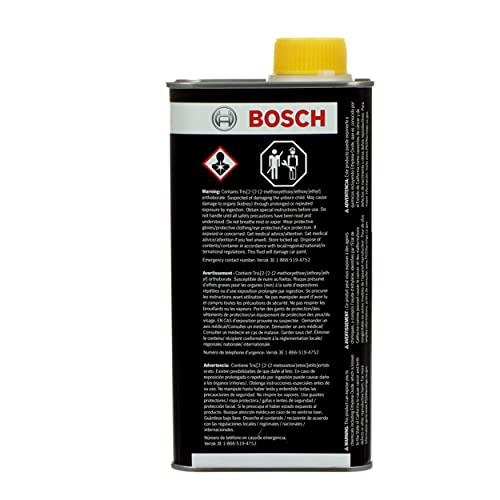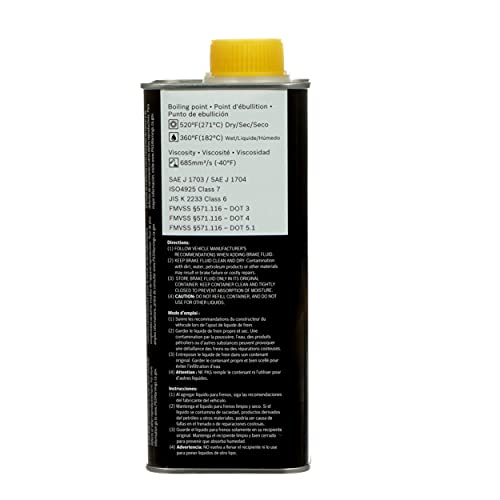
Original price was: €22.99.€19.99Current price is: €19.99.
Bosch ESI6-32N Brake Fluid – 1 Quart Price comparison
Bosch ESI6-32N Brake Fluid – 1 Quart Price History
Bosch ESI6-32N Brake Fluid – 1 Quart Description
Bosch ESI6-32N Brake Fluid – 1 Quart: A High-Performance Solution for Your Vehicle
Discover the Bosch ESI6-32N Brake Fluid, a superior automotive fluid designed to enhance your vehicle’s braking performance. With a commitment to safety and reliability, Bosch delivers a product that ensures your car operates at peak efficiency. From everyday commuting to high-performance driving, this 1-quart brake fluid is ideal for all automotive needs. As you explore our detailed price comparison, you’ll find competitive rates and valuable insights!
Key Features and Benefits of Bosch ESI6-32N Brake Fluid
- Premium Quality: Made with high-grade ceramic materials, Bosch ESI6-32N is formulated to provide exceptional performance under various driving conditions.
- Compatible with Multiple Vehicles: This brake fluid is perfect for most automobiles, ensuring versatility for different makes and models.
- Semi-Synthetic Composition: The innovative formulation offers a high boiling point, reducing the risk of vapor lock and enhancing overall braking efficiency.
- Convenient Packaging: Offered in a 1-quart bottle, it’s easy to measure and pour, making it user-friendly for all car owners.
- Lightweight and Compact: Weighing just 2 pounds and measuring 2.75 x 3.44 x 7.32 inches, it’s easy to store and transport.
- Trusted Brand: Bosch is a globally recognized brand, known for its commitment to quality and innovation in automotive solutions.
Price Comparison: Where to Buy Bosch ESI6-32N Brake Fluid
The Bosch ESI6-32N Brake Fluid is widely available across various retailers. Prices may vary based on location and supplier, giving you plenty of options to choose from. For the best deal, check prices from well-known suppliers in your area and online marketplaces. Click on our price comparison tool to see the latest prices for Bosch ESI6-32N Brake Fluid, ensuring you find the most competitive rates!
6-Month Price History Trends
Our 6-month price history chart for the Bosch ESI6-32N Brake Fluid reveals interesting trends. Over the past half-year, prices have fluctuated, with noticeable discounts during seasonal promotions. Keeping an eye on these trends can help you buy at the best possible price. Stay informed and be proactive when shopping for automotive fluids!
Customer Reviews: Insights from Users
User feedback on the Bosch ESI6-32N Brake Fluid has been overwhelmingly positive. Customers praise its effective formulation, which significantly improved their vehicle’s braking response. Many noted that they experienced enhanced confidence while driving, especially in high-pressure situations. Reviews frequently mention the ease of use, with drivers appreciating the straightforward pouring process.
However, some users have raised concerns regarding the availability at local retailers and the price point compared to generic alternatives. While Bosch ESI6-32N may be slightly more expensive than store-brand fluids, the consensus is that the reliability and performance justify the investment. Investing in quality brake fluid is essential for vehicle safety and performance.
Explore Unboxing and Review Videos
For an in-depth look at the Bosch ESI6-32N Brake Fluid, be sure to check out various unboxing and review videos available on YouTube. These resources offer visual insights into the product’s features and real-world application. Seeing the product in action can help you make an informed purchasing decision. Users often share their experiences, allowing you to gauge what to expect upon usage.
If you are looking to enhance your vehicle’s braking system with a trusted and effective solution, the Bosch ESI6-32N Brake Fluid is an excellent choice. With its high-quality components, beneficial features, and positive customer reviews, this brake fluid stands out in the crowded automotive market. Don’t miss out on securing this product at the best price. Compare prices now!
Bosch ESI6-32N Brake Fluid – 1 Quart Specification
Specification: Bosch ESI6-32N Brake Fluid – 1 Quart
|
Bosch ESI6-32N Brake Fluid – 1 Quart Reviews (7)
7 reviews for Bosch ESI6-32N Brake Fluid – 1 Quart
Only logged in customers who have purchased this product may leave a review.












Brian G. –
While this brake fluid isn’t “OEM” (per se for the perfectionists), it does it is certainly functional and relatively inexpensive. I bought this when I had to replace my master and slave cylinders as well as bleed the clutch on my 2005 Acura TSX. My clutch has been going strong for the past 2 or so months and I wouldn’t hesitate to go with this specific brake fluid or anything else from Bosch again in the future.
C –
Brake Fade? I think so many get stuck at Dry Boiling Point Numbers or Wet Boiling Point Numbers. Many forget that for daily drivers, it is moisture mixing in the brake fluid that requires fluid changes. This is one of the few Dot 5.1s that maintain high wet boiling temps for street use. Race Brake Fluids are designed to be flushed very often, so they don’t hold up as well over a prolonged period of time. That is the exact opposite of what you want from a Brake Fluid for the street. Whether it is a Truck or SUV Towing or a high-performance street car, Castrol React SRF may NOT be what is best for you.
This fluid is up there in wet boiling temps, comes in 32oz/1Qt/950ml so you don’t usually have to guess how many cans you need. It replaces all DOT Brake Fluid from 3, 4, and 5.1 with the exception of 5/5.0 which is silicone based and can not be mixed with other fluids anyways.
Considering Castrol SRF is $70 and this is ~$15, save the $65 and used that towards Stainless Steel Brake Lines for your vehicle. This fluid and those SSBL are a much better improvement for every day, heavy duty street use.
Omar Beltran –
This is an amazing product, you can feel the difference after you change your brake fluid for this, I think that reviews were a little hype on this but really not those are right.
If you don’t have this brake fluid on your brake system, go ahead and change it, you will notice the difference when you use your brake system again…
Dad of All Trades –
Recent findings conducted by the National Car Care Council revealed that 86 percent of the cars they randomly checked during state vehicle inspections, had at least one item that would cause the car to fail. Fifteen percent of these cars had low, contaminated or worn-out brake fluid. To put this another way, more than one in every 10 cars you are traveling with along city streets and highways has the potential of a brake failure due to brake fluid issues.Brake fluid is the key ingredient in any hydraulic braking system. The fluid is not only subjected to hundreds of pounds of pressure on many occasions during your drive, it is also a lubricant for the rubber components in your master cylinder, wheel cylinders, calipers and hoses. Additionally, brake fluid has corrosion inhibitors that keep the bores of hydraulic cylinders from rusting and pitting.
Many of today’s brake fluids are made of polyalkylene glycol which is hygroscopic, meaning it absorbs moisture. This can be a good thing and a bad thing. The absorption of water promotes dispersal throughout the braking system and prevents “pooling” of the absorbed water in low-lying areas of the brake system where corrosive acids can form and make the components deteriorate at a faster rate. Water in a brake system will also freeze or boil faster than the fluid. Hygroscopic properties can be a bad thing, though, because the fluid will actually draw moisture through porous metal surfaces if the fluid has lost its corrosion-preventative abilities.Used fluid, when tested with chemical test strips, can sometimes contain up to 8-10% water contaminants after several years of use. Changing of the fluid whenever a brake component is being replaced is always recommended but seldom done, especially if you are fixing the car in your driveway or garage. Most service shops will recommend a flush and refill be done; however, cost-conscious consumers may opt against this for sake of saving some money on the total bill. A quick search through your owner’s manual will find a recommended service interval of roughly every three years that a flush and refill should be done.
When replacing brake fluid, there are several different types to choose from. The easiest way to determine which fluid your car requires is by consulting your owner’s manual, or by locating the specification stamped on the master cylinder reservoir. Most American-made cars used DOT 3 brake fluid until the mid-1990s. DOT 3 brake fluid has a dry boiling point of 284 degrees, which is fine for brake systems with large brake drums and thick disc brake rotors, where brake heat can be easily dispersed. It has a viscosity of roughly 1500 at -40 F.DOT 4 was used by many British or European cars and is also a poly-glycol base. DOT 4 absorbs less moisture than the DOT 3 fluid, and many enthusiasts have converted their hydraulic brake systems from DOT 3 or DOT 4 for this reason. Changing the fluid is not all that is involved in this conversion, though. To prevent cross contamination you should also change all the rubber components in the brake system. All steel lines and brake hoses need to be flushed, too. DOT 4 has a boiling point of 311 degrees F., and it is rated at a viscosity of 1800 at -40 F.DOT 5 is silicone-based brake fluid and is used in most new cars today. DOT 5 is expensive, but it has a dry boiling point of 356 degrees. Newer brake rotors tend to be smaller and thinner, which means they disperse heat a lot less efficiently. Also, DOT 5 does not absorb any moisture. DOT 5 will not harm painted surfaces and acts as a weather barrier for your brake system, preventing rust. DOT 5 can be used as an upgrade or replacement for both DOT 3 and 4, but should not be mixed with any of the other fluids. The procedures to convert your DOT 3 or 4 systems to the silicone-based DOT 5 are similar to the Dot 4 conversion procedure mentioned above. Silicone-based brake systems tend to be more difficult to bleed, but once this is accomplished, a DOT 5-filled system will resist rust better and last longer than the other formulations. Silicone brake fluid is also much lighter in cold temperatures, only about 900 weight at -40 F.
A new formulation has recently been developed called DOT 5.1. This fluid is identical to DOT 5 silicone in both boiling point and viscosity; however, it is compatible in the poly-glycol based systems and anti-lock brakes as well. DOT 5.1 can be used in place of either of the poly-glycol-based fluids even though it has half the viscosity of DOT 3 or DOT 4 fluid. In fact, DOT 5.1 can be intermixed with the other non-silicone based fluids.Many imports also require special brake fluids be used, so as not to void original equipment vehicle warranties. Pre-2005 Audis and VWs use a Super Dot 4 that is light yellow in color and has a boiling point of 509 degrees F. This fluid was also OE-specified fluid for BMW until mid-2002, and all new Land Rover, Jaguar, Volvo, Porsche and Mercedes. Audi and VWs after 2005 use a low viscosity type DOT 4 LV that is yellow in color and has the same boiling point as Super DOT 4. The LV formulation is also used exclusively on Mini, Saab and BMWs built after mid-2002. Both of these import-specific fluids are available from the manufacturer Pentosin (as well as others) and sold at many dealerships and retailers, but they are not necessarily out front on the shelf with the other more common DOT fluids.
Amazon why do you ship food with brake fluid?
JVK –
My 2009 Camry was due for a brake fluid flush, and I was trying to see what would be the best fluid to buy. After quite of a bit research, this Bosch fluid seemed to stand out. It appears to be better than other fluids in pretty much every aspect. It’s more durable, it has better temperature performance, and best of all it can fit any vehicle with recommended Dot 3, 4 or 5.1 fluid. I was waiting for a good test of brake performance which happened the other day on the 101 freeway. The car in front braked suddenly out of nowhere (I guess the driver wasn’t paying good attention to their front), and this caused me to slam on my brakes. My Camry decelerated very rapidly, and I could hear a mild squeal. It was a very stable deceleration with absolutely no issues. ABS must have been activated as otherwise the car would have slipped. I know the ABS works very well on these Camrys as one time a couple of years ago I had to brake with my old worn out tires on a rainy day, and I could feel the vibration (apply/release) on the brake pedal. The vibration was much faster than my older 1994 Camry, which implies that ABS technology has advanced since then. I would highly recommend this brake fluid to whoever needs Dot 3, 4, or 5.1 fluid.
Dad of All Trades –
I’ve bought this & used in multiple vehicles without any issues & they used dot 3 or 4. No issues as they mix without any problems. One key feature of this product is its viscosity is less or thinner than dot 3&4. This means it will increase the time your antilock breaks kick in. It’s milli-seconds but can mean life or death.
JVK –
It appears to replace a number of DOT fluids and seems to be reasonably priced. On the European car blogs and owners forms there is much said about various imported brake fluids and how much better they might be than, say Prestone and other domestic brands. In this case, the Bosch fluid is not that expensive and appears to be one of those special European imports. Unless one tracks a car, I doubt that many of us will ever benefit from a top-shelf brake fluid, but at least Bosch keeps up appearances without costing a fortune.